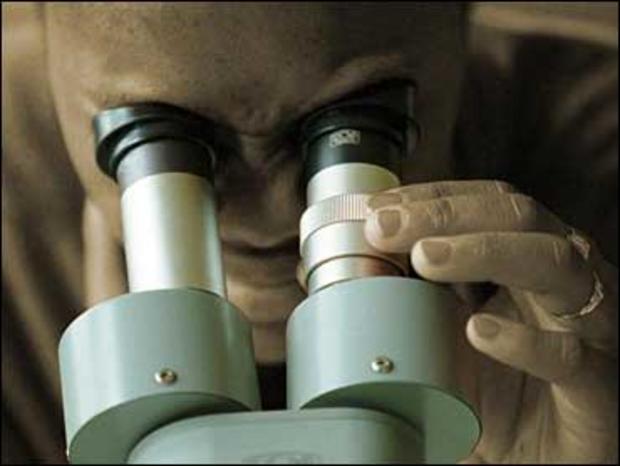Scientist claims discovery of "G-spot"structure, other experts unconvinced
(CBS News) The elusive "G-spot" erogenous zone has finally been discovered, at least according to the author of a new study. Dr. Adam Ostrzenski, a researcher at the Institute of Gynecology in St. Petersburg, Fla. says he discovered the anatomic structure other researchers have been unable to find after conducting an autopsy and hopes his research can improve the field of sexual medicine.
Does a woman's G-spot actually exist? Study has answer
"This study confirmed the anatomic existence of the G-spot, which may lead to a better understanding and improvement of female sexual function," Ostrzenski, who had previously been a professor of gynecology at Florida International University, said in a written statement.
So where exactly is the G-spot? Ostrzenski told HealthPop that deep inside the vaginal wall there is sac that houses a structure. Once the sac is opened there is a white-colored membrane that serves like a "blanket," and once Ostrzenski removed it, he discovered a very small "bluish grape-like" cluster that he says is the G-spot. The spot has three distinct regions, says Ostrzenski and includes a rope-like vessel structure that appears to be erectile tissue located between layers of the vaginal wall. He said once filled with blood, the structure would elevate towards adjacent structures. The discovery came after a dissection of an 83-year-old Polish woman. According to the Los Angeles Times, Poland allows the dissection of human remains soon after death, when fine distinctions in tissue remain easy to see. Ostrzenski's study is published online in the April 25 issue of the Journal of Sexual Medicine.
The new study follows a January review of 60 years worth of scientific literature on the hard-to-spot erogenous zone, also published in the Journal of Sexual Medicine, that found no evidence of any anatomic structure that may be a G-spot, HealthPop reported.
"Without a doubt, a discreet anatomic entity called the G-spot does not exist," study author Dr. Amichai Kilchevsky, a urology resident at Yale-New Haven Hospital in Connecticut, said at the time.
Commenting on Ostrzenski's new study, Kilchevsy told MSNBC "It's speculation. It is almost impossible to say what it is, based on what he describes."
That sentiment is shared with other experts in the field. "It's a single case study involving the dissection of the body of one woman whose sexual experiences are unknown to us," sex researcher Dr. Debby Herbenick, a sexual-health educator at the Kinsey Institute wrote in a blog on The Daily Beast. "We don't know how many women (if any) have similar structures."
Sexual medicine researcher Dr. Barry Komisaruk, professor of psychology at Rutgers University co-wrote a critical commentary on Ostrzenski's new study that he anticipates will be published in the print issue of the same journal. The commentary sent to HealthPop, which was co-authored by researchers Dr. Emmanuele A. Jannini, of the University of L'Aquila in Italy and Dr. Beverly Whipple, past-director of the International Society for the Study of Women's Sexual Health who coined the term "G-spot" in 1981 , reads, "We submit that the author's claim to have discovered 'the' G-spot does not fulfill the most fundamental scientific criteria."
The single biggest shortcoming in the research, Dr. Komisaruk told HealthPop in an email, was that Ostrzenski failed to characterize the type of tissue he dissected, "which is standard procedure." Komisaruk says a microscope could have easily identified whether the tissue in question is glandular, erectile, a blood vessel or other type of duct, whether the tissue contains nerves or muscle tissue.
"These are basic questions that could inform the possible function of the dissected tissue," Komisaruk told HealthPop. "Without such information, there is no indication of what function it might serve."
Komisaruk's research suggests the G-spot isn't a specific anatomic structure, but a zone or area that's activated when pressure is placed on the vagina's anterior wall. That pressure, he said, is actually pushing on other sensitive structures including the urethra, Skene's gland (also known as the "female prostate"), and clitoris.
The infamous G-spot was named for German gynecologist Ernst Grafenberg, who in 1950 wrote, "an erotic zone always could be demonstrated on the anterior wall of the vaginal along the course of the urethra." Sex researchers Dr. John Perry and Dr. Beverly Whipple dubbed this area the G-spot in 1981 when they replicated Grafenberg's findings in their own research.
Dr. Whipple told HealthPop in an email that the area her and Dr. Perry identified is composed of many tissues, and more research is needed in this area since no one woman is the same when it comes to sexual experiences.
"Each woman is different and unique and each woman has different sensual and sexual experiences that provide her with pleasure and satisfaction," Whipple said. "Let's not try to fit women into one model of sensuous and sexual response."
Ostrzenski defended his work in an interview with HealthPop, saying he only
looked for the presence of an anatomical structure and his study was not
designed to assess function because that would have required him to electrically
stimulate a deceased subject.
"Histology is a separate branch of medicine, anatomy is different," Ostrzenski said. The authors in the commentary are "talking about microscopic examination which the study was not designed for at this moment."

